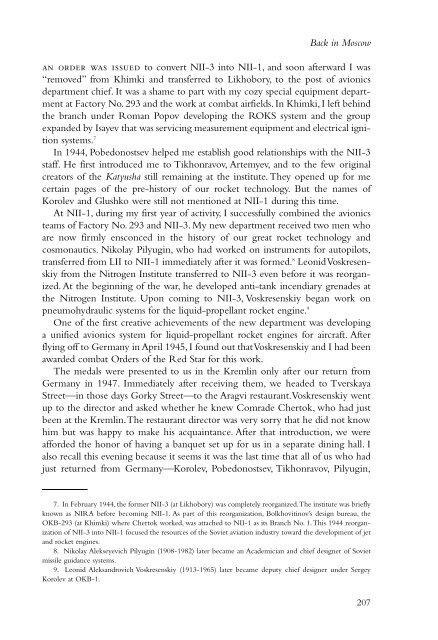to open next chapter. - NASA's History Office
to open next chapter. - NASA's History Office
to open next chapter. - NASA's History Office
You also want an ePaper? Increase the reach of your titles
YUMPU automatically turns print PDFs into web optimized ePapers that Google loves.
Back in Moscow<br />
an order was issued <strong>to</strong> convert NII-3 in<strong>to</strong> NII-1, and soon afterward I was<br />
“removed” from Khimki and transferred <strong>to</strong> Likhobory, <strong>to</strong> the post of avionics<br />
department chief. It was a shame <strong>to</strong> part with my cozy special equipment department<br />
at Fac<strong>to</strong>ry No. 293 and the work at combat airfields. In Khimki, I left behind<br />
the branch under Roman Popov developing the ROKS system and the group<br />
expanded by Isayev that was servicing measurement equipment and electrical ignition<br />
systems. 7<br />
In 1944, Pobedonostsev helped me establish good relationships with the NII-3<br />
staff. He first introduced me <strong>to</strong> Tikhonravov, Artemyev, and <strong>to</strong> the few original<br />
crea<strong>to</strong>rs of the Katyusha still remaining at the institute. They <strong>open</strong>ed up for me<br />
certain pages of the pre-his<strong>to</strong>ry of our rocket technology. But the names of<br />
Korolev and Glushko were still not mentioned at NII-1 during this time.<br />
At NII-1, during my first year of activity, I successfully combined the avionics<br />
teams of Fac<strong>to</strong>ry No. 293 and NII-3. My new department received two men who<br />
are now firmly ensconced in the his<strong>to</strong>ry of our great rocket technology and<br />
cosmonautics. Nikolay Pilyugin, who had worked on instruments for au<strong>to</strong>pilots,<br />
transferred from LII <strong>to</strong> NII-1 immediately after it was formed. 8 Leonid Voskresenskiy<br />
from the Nitrogen Institute transferred <strong>to</strong> NII-3 even before it was reorganized.<br />
At the beginning of the war, he developed anti-tank incendiary grenades at<br />
the Nitrogen Institute. Upon coming <strong>to</strong> NII-3, Voskresenskiy began work on<br />
pneumohydraulic systems for the liquid-propellant rocket engine. 9<br />
One of the first creative achievements of the new department was developing<br />
a unified avionics system for liquid-propellant rocket engines for aircraft. After<br />
flying off <strong>to</strong> Germany in April 1945, I found out that Voskresenskiy and I had been<br />
awarded combat Orders of the Red Star for this work.<br />
The medals were presented <strong>to</strong> us in the Kremlin only after our return from<br />
Germany in 1947. Immediately after receiving them, we headed <strong>to</strong> Tverskaya<br />
Street—in those days Gorky Street—<strong>to</strong> the Aragvi restaurant.Voskresenskiy went<br />
up <strong>to</strong> the direc<strong>to</strong>r and asked whether he knew Comrade Cher<strong>to</strong>k, who had just<br />
been at the Kremlin.The restaurant direc<strong>to</strong>r was very sorry that he did not know<br />
him but was happy <strong>to</strong> make his acquaintance. After that introduction, we were<br />
afforded the honor of having a banquet set up for us in a separate dining hall. I<br />
also recall this evening because it seems it was the last time that all of us who had<br />
just returned from Germany—Korolev, Pobedonostsev, Tikhonravov, Pilyugin,<br />
7. In February 1944, the former NII-3 (at Likhobory) was completely reorganized.The institute was briefly<br />
known as NIRA before becoming NII-1. As part of this reorganization, Bolkhovitinov’s design bureau, the<br />
OKB-293 (at Khimki) where Cher<strong>to</strong>k worked, was attached <strong>to</strong> NII-1 as its Branch No. 1.This 1944 reorganization<br />
of NII-3 in<strong>to</strong> NII-1 focused the resources of the Soviet aviation industry <strong>to</strong>ward the development of jet<br />
and rocket engines.<br />
8. Nikolay Alekseyevich Pilyugin (1908-1982) later became an Academician and chief designer of Soviet<br />
missile guidance systems.<br />
9. Leonid Aleksandrovich Voskresenskiy (1913-1965) later became deputy chief designer under Sergey<br />
Korolev at OKB-1.<br />
207
















